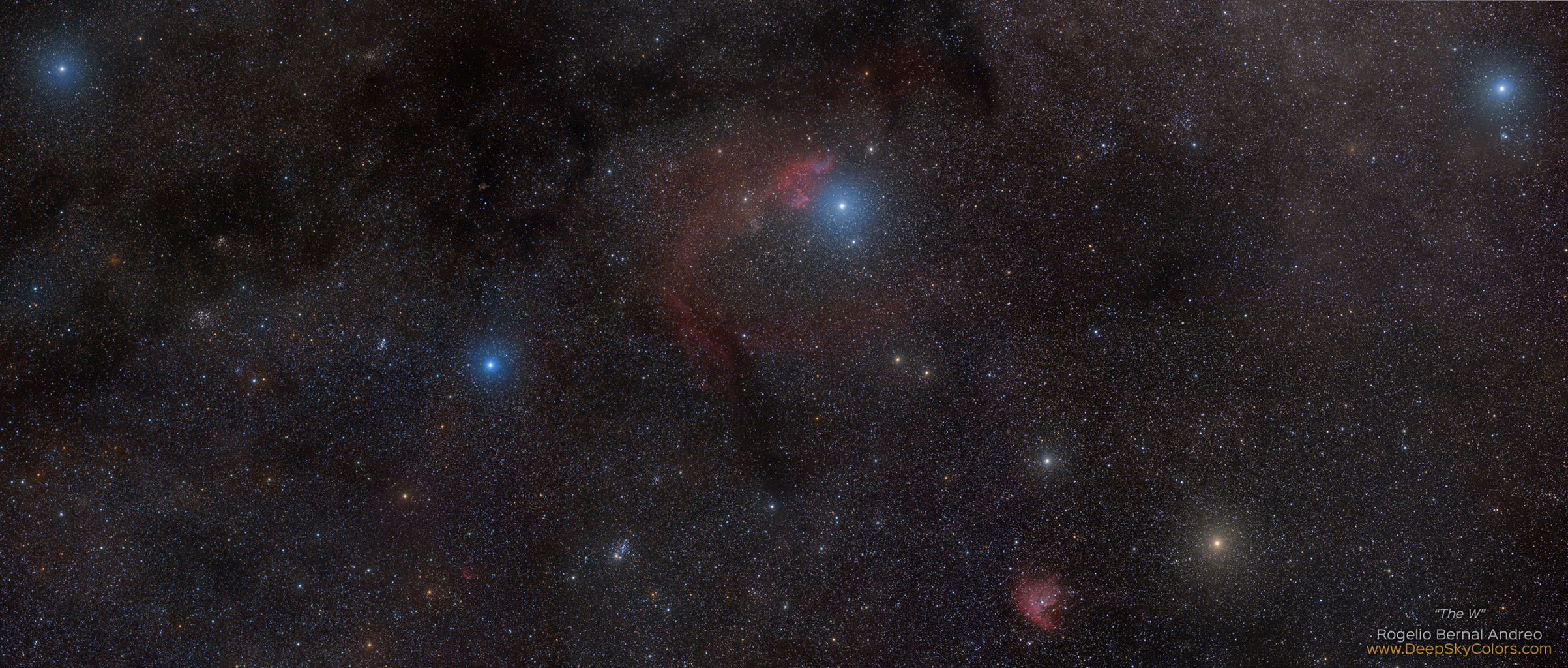
Copyright:Rogelio Bernal
Andreo
原文:
A familiar, zigzag, W pattern in northern constellation Cassiopeia is traced by five bright stars in this colorful and broad mosaic. Stretching about 15 degrees across rich starfields, the celestial scene includes dark clouds, bright nebulae, and star clusters along the Milky Way. In yellow-orange hues Cassiopeia’s alpha star Shedar is a standout though. The yellowish giant star is cooler than the Sun, over 40 times the solar diameter, and so luminous it shines brightly in Earth’s night from 230 light-years away. A massive, rapidly rotating star at the center of the W, bright Gamma Cas is about 550 light-years distant. Bluish Gamma Cas is much hotter than the Sun. Its intense, invisible ultraviolet radiation ionizes hydrogen atoms in nearby interstellar clouds to produce visible red H-alpha emission as the atoms recombine with electrons. Of course, night skygazers in the Alpha Centauri star system would also see the recognizable outline traced by Cassiopeia’s bright stars. But from their perspective a mere 4.3 light-years away they would see our Sun as a sixth bright star in Cassiopeia, extending the zigzag pattern just beyond the left edge of this frame.
中文翻譯:
在北方星座卡西歐佩亞 (Cassiopeia) 中,有五顆明亮的星星,形成熟悉的鋸齒形 W 形狀,這幅色彩繽紛且廣闊的馬賽克圖案,橫跨約 15 度的豐富星野。其中包含了黑暗雲層、明亮的星雲及星團,展現了銀河系的璀璨景象。在黃色-橙色的色調中,卡西歐佩亞的阿爾法星(Shedar)尤為突出。這顆黃巨星比太陽冷卻,直徑超過太陽的 40 倍,並且以其驚人的亮度從 230 光年外的距離,明亮地閃耀在地球的夜空中。位於 W 字形中心的伽馬星(Gamma Cas)是一顆大質量且快速旋轉的星,距離地球約 550 光年。這顆藍色的伽馬星比太陽熱得多,它強烈的紫外線輻射離子化附近星際雲中的氫原子,並當這些原子與電子重新結合時,產生可見的紅色 H-alpha 發射。當然,位於半人馬座的夜空觀察者也能看到卡西歐佩亞明亮星星所勾勒出的可辨識輪廓,但從他們的視角,距離僅 4.3 光年,他們還會將我們的太陽視為卡西歐佩亞中的第六顆明亮星,延展出在畫面左邊的鋸齒形模式。
#卡西歐佩亞 #Shedar #GammaCas #星空 #銀河系 #天文學 #夜空觀察 #宇宙 #星際雲 #亮星 #天文奇觀
來源:NASA每日圖片


